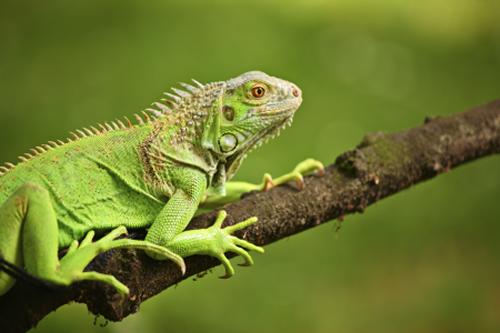Keeping Rainforest Reptiles as Pets

You don't always have to travel to the rainforest to see some of the animals there. Sometimes you'll find rainforest animals at the pet store and you can keep them in your own home. The most common rainforest animals kept as pets are snakes, lizards, frogs, and tarantulas.
The key to keeping one of these rainforest animals happy and healthy is to mimic it's natural environment as closely as possible.
Here are the basics of what you'll need as a minimum to keep reptiles:
Cage or Terrarium
It is very important to pick out the proper habitat for your reptile. The size of it's cage will be determined by the size of your reptile. If you buy a cage that is too small your reptile won't get enough exercise. There must also be adequate ventilation. Both snakes and lizards will need rocks and caves for hiding places. You'll also probably need branches and twigs for your reptile to climb on.
Water & Humidity Source
Your reptile will need a water source. What type you need will vary depending upon what kind of reptile you have. Some reptile species will drink water from a bowl and some will not.
For example, chameleons will not drink water from a bowl. Instead they lick water drops or dew off of leaves. If you just place a bowl of water in your chameleon's cage it will not survive. For a chameleon you'll need a misting system instead. You'll find a variety of misting systems, misting bottles, and other types of reptile water sources at Swell Reptiles. You will also need a hygrometer to measure the humidity level in your reptile's cage.
Although some reptiles will drink from a water bowl, you'll still need some sort of water mister.
Light and Heat Source
Reptiles are cold-blooded, meaning that their temperature is regulated by the external environment, rather than internally like warm-blooded animals. Different reptile species have specific needs regarding their heat and light needs. Your reptile won't survive if these needs are not met. In their natural environment reptiles are free to move around from one area to another to meet their heat and light requirements. In the artifical environment of a terrarium, you must provide these different temperature and light gradients for your pet. What this means is that there must be a change in temperature across your reptile habitat so that your pet can move across the temperature gradient as needed in order to regulate their temperature. You'll need at least one thermometer in your reptile cage and two would be better so you can measure the temperature in different areas of the habitat.
A temperature gradient can often be created by providing caves, the inside of which would be shielded from the light or heat source.
You can provide heating by the overhead light as well as ceramic heaters, heat rocks, and heat mats that are placed inside the habitat. Make sure that your reptile has room to move off the heat source or it will get too hot.
The light source must provide ultraviolet (UV) light or your reptile won't survive. Keeping a consistent light/dark cycle is also important.
Food
You'll need to provide a balanced diet to keep your reptile healthy. Food requirements will be specific to your particular reptile species. For example, some reptiles will be happy eating things like crickets, but others, such as many snake species, are going to need to eat mice. You'll also need some sort of food bowl for your reptile. You can also find frozen reptile foods.
Conclusion
This article only provides a general overview of keeping rainforest reptiles as pets. In order to keep your specific reptile species healthy and happy you'll need to do some further research. There are many books available that are dedicated to keeping specific species of reptiles that will outline exactly what care requirement are needed for a given reptile species.
In addition, you can sometimes find "reptile species kits" that provide many of the necessary items for a given species, such as chameleon kits or gecko kits. These come with the proper habitat and accessories for a specific species. Likewise you can often find food preparations for specific species. Even so, it is still best to do your research to ensure that you can keep your reptile as healthy and happy as possible.
